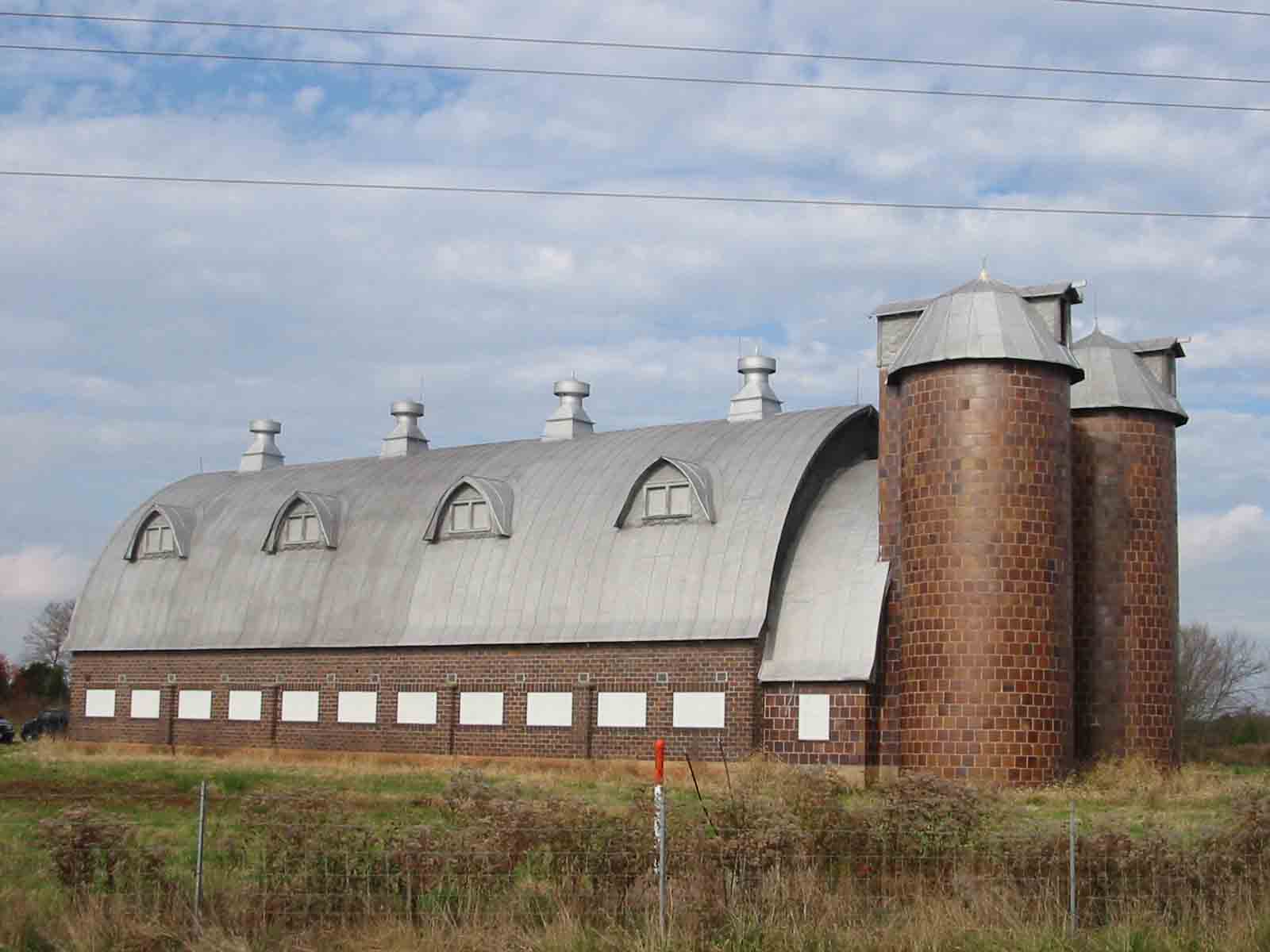| Innovation Barn |
|
by Debbie Robison December 2003 |
| LOCATION |
|
Innovation
Barn is located on a parcel at the northwest quadrant of the intersection of
Route 234-bypass and Route 28. |
| SITE HISTORY |
|
Upon
first working the land, Thomasson, known as W.T., was a subsistence farmer
growing wheat and corn. After several years, he saved enough money to purchase
a The
milking barn was constructed using Textile hollow-tile terra cotta blocks,
which could be purchased from local farm supply stores. The face of the block
was finished with a rough surface to resemble brick. Several manufacturers
produced hollow-tile terra cotta blocks including The Hollow Tile Building
Association of Chicago, which made the MasTerTile brand, Unidilla Silo of Thomasson’s
two-story barn utilized the first floor for milking cows and the second floor
for hay storage. Two silos stored feed grain. The barn design is typical of
plans for milking barns seen in agricultural publications. Hunt, Helm, Ferris
and Company designed The Starr Line, available from their catalog. The plans
closely resemble the design of Thomasson’s barn, though the Thomasson barn was
constructed with a round roof rather than a gambrel roof. Like the gambrel
roof, the round-roof configuration utilized sawn lumber and eliminated the need
for supporting joists, thus increasing the hayloft capacity.[9] Thomasson,
like his neighbors, sold his milk to suppliers in In
support of his dairy farming, Thomasson grew corn and wheat; surplus hay was sold
by the carload. He studied farming and dairy techniques in order to use the
most advanced production methods. Record keeping was a business tool he used to
make management decisions in an effort to optimize production. His four
daughters assisted with milking the cows. Daughter Agnes recalled milking 60
cows per day and being able to milk faster than a milking machine.[11]
Through the years, Thomasson acquired additional land, increasing his holdings
to 452 acres. After
Thomasson’s death on March 29 1950, his daughters, Elizabeth Kline, Agnes
Huffman, Claudia Compton, and Sallie Ball, sold the farm, livestock, and
equipment to George Dickerson. An inventory of personal property sold
highlights the types of livestock and equipment used to operate the farm. Both
motorized and horse drawn farm equipment reflects industrial advances during
the period he operated the farm. The Dickerson family held the farm for ten
years before selling the land to development in 1960.[12]
The barn has remained vacant since. Except for the barn, all other buildings
and structures on the site have been demolished. |
| THE RISE AND DECLINE OF THE DAIRY INDUSTRY IN PRINCE WILLIAM COUNTY |
|
The
first quarter of the 20th century saw an increase in the number of
dairy operations in In
[1]
“Maneuver Grounds Prince William and Fairfax Counties Surveyed Under the
Direction of Maj. Edward Burr, Corp. of Engineers,” June-July 1904,
Prince William County Public Library, Relic Room, Map drawer, [2] Prince
William County Deed Book 54, page 266, Prince William County Circuit Court Copy
Room, [3] Helen Graves, “Old Barn is Testament to One Man’s Commitment to Education for His Four Girls,” The Bull Run Observer, April 19, 2000, p. 3, Prince William County Public Library, Relic Collection, Diarying folder, Manassas, VA. [4] [5] Adena
Landry and John Vlach, “Terra Cotta Dairy Barns of [6] Ibid. pp. 10, 20. [7] [8] Landry and Vlach. [9] Ibid. [10] “Milk Scarcity,” The Manassas Journal, March 21, 1919, p. 1, microfilm, Prince William County Public Library, Relic Collection. [11] Graves p. 3 [12] Prince
William County Deed Book 257, page 479, Prince William County Circuit Court
Copy Room, [13] “Milk Scarcity,” The Manassas Journal, March 21, 1919, p. 1, microfilm, Prince William County Public Library, Relic Collection. [14] Ken
Bailey, “Opportunities for Success on Small Dairy Farms Revisited,” paper
presented at the 35th Annual Conference of the American Association
of Bovine Practitioners, [15] USDA, “1997 Census of Agriculture – State Data, Table 1. Historical Highlights: 1997 and Earlier Census Years,” National Agricultural Statistics Service. [16] Steven
Manheimer, “ [17] USDA,
“1997 Census of Agriculture – [18] USDA, “1997 Census of Agriculture – Virginia County Data, Table 12, Farms With Sales of $10,000 or More: 1997 and 1992,” National Agricultural Statistics Service. |

 Around the turn of the 20th century, the land on which the Innovation Barn
would be built was cultivated with corn by the farm’s owner, L.J. Hornbaker.
Around the turn of the 20th century, the land on which the Innovation Barn
would be built was cultivated with corn by the farm’s owner, L.J. Hornbaker.